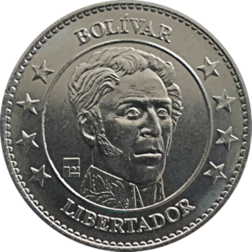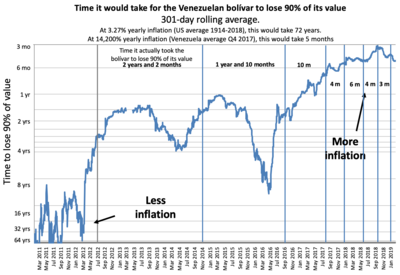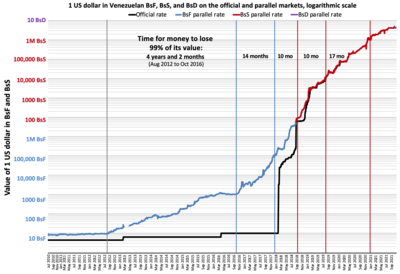
A | B | C | D | E | F | G | H | CH | I | J | K | L | M | N | O | P | Q | R | S | T | U | V | W | X | Y | Z | 0 | 1 | 2 | 3 | 4 | 5 | 6 | 7 | 8 | 9
| bolívar digital venezolano (Spanish) | |
|---|---|
 1 bolivar coin | |
| ISO 4217 | |
| Code | VED (numeric: 926) VES (numeric: 928) ISO 4217 Standard definition:
|
| Subunit | 0.01 |
| Unit | |
| Unit | bolívar |
| Plural | bolívares |
| Symbol | Bs. [1] or Bs.D |
| Nickname | bolo(s), luca(s), real(es) |
| Denominations | |
| Subunit | |
| 1⁄100 | céntimo |
| Banknotes | VED series: Bs. 5, Bs. 10, Bs. 20, Bs. 50, Bs. 100 |
| Coins | 25, 50 céntimos, Bs. 1 |
| Demographics | |
| User(s) | |
| Issuance | |
| Central bank | Banco Central de Venezuela |
| Website | www |
| Valuation | |
| Inflation | |
| Value | Official rate US$1 = Bs.D 35,7247 (December 15, 2023)[1] Parallel rate US$1 = Bs.D 37.49 (December 15, 2023)[5] |
The bolívar [boˈliβaɾ] is the official currency of Venezuela. Named after the hero of South American independence Simón Bolívar, it was introduced following the monetary reform in 1879, before which the venezolano was circulating. Due to its decades-long reliance on silver and gold standards, and then on a peg to the United States dollar, it was considered among the most stable currencies and was internationally accepted until 1964, when the government decided to adopt a floating exchange rate instead.
Since 1983, the currency has experienced a prolonged period of high inflation, losing value almost 500-fold against the US dollar in the process. The depreciation became manageable in the mid-2000s, but it still stayed in double digits.[6] It was then, on 1 January 2008, that the hard bolívar (bolívar fuerte in Spanish, sign: Bs.F, code: VEF) replaced the original bolívar (sign: Bs; code: VEB) at a rate of Bs.F 1 to Bs. 1,000[1][7] (the abbreviation Bs. is due to the first and the final letters of the plural form of the currency's name, bolívares).
The value of the hard bolívar, pegged to the US dollar, did not stay stable for long despite attempts to institute capital controls. Venezuela entered another period of abnormally high inflation in 2012, which the country has not exited as of April 2023[update]. The central bank stuck to the pegged subsidised exchange rate until January 2018, which was overpriced so people began using parallel exchange rates despite a ban on publishing them. From 2016 to 2019 and again in 2020, the currency experienced hyperinflation for a total period of 38 months.[8]
The rampant inflation prompted two redenominations. The first occurred in August 2018, when Bs.F 100,000 were exchanged for 1 sovereign bolívar (bolívar soberano in Spanish, sign: Bs.S, code: VES),[9] and another one happened on 1 October 2021, but called "Nueva expresión monetaria" or new monetary expression, which removes 6 zeros from the currency without affecting its denomination but did introduce a new ISO code VED[10][a] at a rate of Bs.S 1,000,000 = Bs.D 1,[11] thus making Bs.D 1 worth Bs. 100,000,000,000,000 (1014, or Bs. 100 trillion in short scale).
Both currencies are in circulation,[12] though the economy has undergone extensive currency substitution, so the majority of transactions happen in US dollars, or, to a lesser extent, the Colombian peso.[8][11][13]
History
Bolívar
| Preceded by: Venezolano Reason: unification of circulating currencies Ratio: 1⁄5 venezolano = 1 bolívar |
Currency of Venezuela 31 March 1879 – 31 December 2007 |
Succeeded by: Hard bolívar Reason: inflation Ratio: 1000 bolívares = 1 hard bolívar |
| bolívar (Spanish) | |
|---|---|
| ISO 4217 | |
| Code | VEB |
| Unit | |
| Plural | bolívares |
| Symbol | Bs |
| Denominations | |
| Subunit | |
| 1⁄100 | céntimo |
| Plural | |
| céntimo | céntimos |
| Banknotes | Bs. 1,000, Bs. 2,000, Bs. 5,000, Bs. 10,000, Bs. 20,000, Bs. 50,000 |
| Coins | Bs. 10, Bs. 20, Bs. 50, Bs. 100, Bs. 500, Bs. 1,000 |
| Demographics | |
| User(s) | |
| Issuance | |
| Central bank | Banco Central de Venezuela |
| Website | www |
| This infobox shows the latest status before this currency was rendered obsolete. | |
The bolívar is named after the hero of South American independence Simón Bolívar. The bolívar was adopted by the monetary law of 1879, replacing the short-lived venezolano at a rate of five bolívares to one venezolano. Initially, the bolívar was defined on the silver standard, equal to 4.5 g fine silver, following the principles of the Latin Monetary Union. The monetary law of 1887 made the gold bolívar unlimited legal tender, and the gold standard came into full operation in 1910. Venezuela went off gold in 1930, and in 1934, the bolívar exchange rate was fixed in terms of the US dollar at a rate of Bs. 3.914 = US$1, revalued to Bs. 3.18 = 1 US dollar in 1937, a rate which lasted until 1941. Until 18 February 1983 (now called Viernes Negro, Spanish for Black Friday, by many Venezuelans),[14] the bolívar had been the region's most stable and internationally accepted currency. It then fell prey to high devaluation.
Exchange controls were imposed on February 5, 2003, to limit capital flight.[15] The rate was pegged to the US dollar at a fixed exchange rate of Bs. 1,600 to the dollar.
Hard bolívar
| Preceded by: Bolívar Reason: inflation Ratio: 1000 bolívares = 1 hard bolívar |
Currency of Venezuela 1 January 2008 – 20 August 2018 |
Succeeded by: Sovereign bolívar Reason: hyperinflation Ratio: 100,000 hard bolívares = 1 sovereign bolívar |
| bolívar fuerte (Spanish) | |
|---|---|
| ISO 4217 | |
| Code | VEF |
| Unit | |
| Plural | bolívares fuertes |
| Symbol | Bs.F or Bs. |
| Nickname | bolo(s), luca(s), real(es) |
| Denominations | |
| Subunit | |
| 1⁄100 | céntimo |
| Banknotes | |
| Freq. used | Bs.F 1,000, Bs.F 2,000, Bs.F 5,000, Bs.F 10,000, Bs.F 20,000, Bs.F 100,000[1] |
| Rarely used | Bs.F 2, Bs.F 5, Bs.F 10, Bs.F 20, Bs.F 50, Bs.F 100, Bs.F 500 |
| Coins | |
| Rarely used | Bs.F 1, Bs.F 10, Bs.F 50, and Bs.F 100[1] |
| Demographics | |
| User(s) | |
| Issuance | |
| Central bank | Banco Central de Venezuela |
| Website | www |
| Valuation | |
| Inflation | |
| Pegged with | US$1 = BsF. 248,832 (Dicom auction)[1] (see this section for parallel market rate)[18] |
| This infobox shows the latest status before this currency was rendered obsolete. Coins and low-value banknotes were rendered obsolete by hyperinflation. | |
The government announced on 7 March 2007 that the bolívar would be redenominated at a ratio of 1,000 to 1 on 1 January 2008 and renamed the bolívar fuerte, or hard bolívar in an effort to facilitate the ease of transaction and accounting.[19] The newer name literally means "hard bolívar", as in hard currency, and in reference to an old coin called the peso fuerte worth 10 Spanish reales.[20] The alternate meaning of "strong" was also used by the government in promotional material[21][22] The official exchange rate is restricted to individuals by CADIVI, which imposes an annual limit on the amount available for travel.

Since the government of Hugo Chávez established strict currency controls in 2003, there have been a series of five currency devaluations, disrupting the economy.[23] On 8 January 2010, the value was changed by the government from the fixed exchange rate of Bs.F 2.15 to Bs.F 2.60 for some imports (certain foods and healthcare goods) and Bs.F 4.30 for other imports like cars, petrochemicals, and electronics.[24] On 4 January 2011, the fixed exchange rate became Bs.F 4.30 for US$1.00 for both sides of the economy. On 13 February 2013 the hard bolívar was devalued to Bs.F 6.30 per US$1 in an attempt to counter budget deficits.[25] On 18 February 2016, President Maduro used his newly granted economic powers to devalue the official exchange rate of the hard bolívar from Bs.F 6.30 per US$1 to Bs.F 10 per US$1, which is a 37% depreciation against the US dollar.[26]
The hard bolívar entered hyperinflation in November 2016.[27]
On January 26, 2018, the government retired the protected and subsidized Bs.F 10 per US$1 exchange rate that was highly overvalued as a result of rampant inflation.[28] On February 5, 2018, the Central Bank of Venezuela announced a 99.6% [sic] devaluation, with the exchange rate going to Bs.F 25,000 per US$. This made the hard bolívar the second-least-valued circulating currency in the world based on the official exchange rate, behind only the Iranian rial, and between September 2017 and August 2018, according to the informal exchange rate, the hard bolívar was the least-valued circulating currency unit in the world.[29][dubious – discuss]
The official exchange rate stood at Bs.F 248,832 to US$1 as of August 10, 2018, making it the least-valued circulating currency in the world based on official exchange rates.[30]
In June 2018, the government authorized a new exchange rate for buying, but not selling, currency. On August 13, 2018, the rate was Bs.F 4,010,000 to US$1, according to ZOOM Remesas.[31]
Sovereign bolívar
| Preceded by: Hard bolívar Reason: hyperinflation Ratio: 100,000 hard bolívares = 1 sovereign bolívar |
Currency of Venezuela 20 August 2018 – |
| bolívar venezolano (Spanish) | |
|---|---|
| ISO 4217 | |
| Code | VES (numeric: 928) |
| Subunit | 0.01 |
| Unit | |
| Plural | bolívares |
| Symbol | Bs. or Bs.S |
| Nickname | bolo(s), luca(s), real(es) |
| Denominations | |
| Subunit | |
| 1⁄100 | céntimo |
| Banknotes | VES series: Bs.S 10,000, Bs.S 20,000, Bs.S 50,000, Bs.S 200,000, Bs.S 500,000, Bs.S 1,000,000 |
| Demographics | |
| User(s) | |
| Issuance | |
| Central bank | Banco Central de Venezuela |
| Website | www |
| Valuation | |
| Inflation | |
On 22 March 2018, President Nicolás Maduro announced a new monetary reform program, with a planned revaluation of the currency at a ratio of 1,000 to 1.[35] The change was to be made effective from 4 June 2018.[36][37]
In May 2018, the government required prices to be expressed in both hard bolívares and sovereign bolívares at the then-planned rate of 1,000 to 1. For example, one kilogram of pasta was shown with a price of Bs.F 695,000 and Bs.S 695. Prices expressed in the new currency were rounded to the nearest 50 céntimos as that was expected to be the lowest denomination in circulation at launch. The rounding created difficulties because some items and sales qualities were priced at significantly less than Bs.S 0.50; for example a litre of gasoline and a Caracas Metro ticket typically cost Bs.S 0.06 and Bs.S 0.04, respectively.[38]
The change in currency was originally scheduled for June 4, 2018. The President delayed the planned June launch date of the sovereign bolívar, citing from Aristides Maza, "the period established to carry out the conversion is not enough".[39] The revaluation was rescheduled to 20 August 2018, and the rate changed to 100,000 to 1, with prices being required to be expressed at the new rate starting 1 August 2018.[40]
On 20 August 2018, the Maduro government launched the new sovereign bolívar currency,[41] with Bs.S 1 worth Bs.F 100,000. New coins in denominations of 50 céntimos and Bs.S 1, and new banknotes in denominations of Bs.S 2, Bs.S 5, Bs.S 10, Bs.S 20, Bs.S 50, Bs.S 100, Bs.S 200 and Bs.S 500 were introduced.[42] Under the country's official fixed exchange rate to the US dollar the new currency was devalued by roughly 95% compared to the old hard bolívar.[43] The day was declared a bank holiday to allow the banks to adjust to the new currency.[44] Initially, during a transition period the sovereign bolívar was to be run alongside the hard bolívar.[45] However, from the start of the transition, on 20 August, hard bolívar notes of Bs.F 500 and less could not be used; only deposited at banks.[46]
Concurrently with the release of the new currency, the minimum wage was raised to Bs.S 1,800 per month,[47] a 33-fold increase,[48] and sales tax increased from 12% to 16%.[48]
Additionally, the sovereign bolívar is supposed to have a fixed exchange rate to the petro cryptocurrency, with a rate of Bs.S 3,600 to one petro;[49][50] a peg of petro and sovereign bolívar was announced by Maduro as early as August 2018.[51][52] The petro is supposedly tied to the price of a barrel of oil (about US$60 in August 2018).[49][50] As of the end of August 2018, there is no evidence that the cryptocurrency is being traded.[53] Petro is regarded by many as a scam.[54][53][55]
Following the introduction of the sovereign bolívar, inflation increased from 61,463% on 21 August 2018 to 65,320% on 22 August 2018.[54] By 24 August 2018, the introduction of the sovereign bolívar had not prevented hyperinflation.[56] According to inflation analyst Steve Hanke, between 18 August and 21 August 2018, the inflation rate increased from 48,760% to 65,320%.[27][54] In October 2021, the country removed six zeroes from its currency while adapting a newer version of the bolivar currency system under a project known as "Digital bolivar".[57][58]
Digital bolívar
A new bolívar, the digital bolívar, was introduced on 1 October 2021 at a rate of Bs.S 1,000,000 to Bs.D 1. This is not a replacement of the sovereign bolívar, since sovereign bolivar banknotes continued to be accepted at the established ratio of 1 million sovereign bolivars to 1 digital bolivar.[59] The currency has the ISO 4217 currency code "VED".
Currency black market

The black (or parallel) market value of the hard bolívar and the sovereign bolívar has been significantly lower than the fixed exchange rate and other rates set by the Venezuelan government (SICAD, SIMADI, DICOM). In November 2013, it was almost one-tenth that of the official fixed exchange rate of Bs.F 6.30 per US dollar.[60] In September 2014, the currency black market rate for the hard bolívar reached 100 VEF/USD;[61] on 25 February 2015, it went over 200 VEF/USD.[62] on 7 May 2015, it was over 275 VEF/USD and on 22 September 2015, it was over 730 VEF/USD.[63] Venezuela still had the highest inflation rate in the world in July 2015.[64] By 3 February 2016, this rate reached 1,000 VEF/USD. This rate surpassed 4,300 VEF/USD on 10 December 2016. It surpassed 10,000 VEF/USD on 28 July 2017, and on 7 September 2017, the rate surpassed 20,000 VEF/USD for the first time. Inflation accelerated, and on 1 December 2017, it reached 100,000 VEF/USD for the first time ever. The rate surpassed 200,000 VEF/USD on 18 January 2018, then 500,000 VEF/USD on 16 April, 1 million VEF/USD on 30 May, 2 million VEF/USD on 7 June, and 5 million VEF/USD on 16 August.[5]
At the time of redenomination on 20 August 2018, the exchange rate was 59.21 VES/USD. By the end of the month it reached 87 VES/USD. The rate then surpassed 100 VES/USD on 3 October 2018, 1,000 VES/USD on 9 January 2019, 10,000 VES/USD on 19 July, 100,000 VES/USD on 6 April 2020, and reached the 1,000,000 VES/USD on 23 November 2020. According to DolarToday, the parallel exchange rate was 4,146,022 VES/USD as of 30 August 2021.[5]
Exchange rate history
It is illegal to publish the "parallel exchange rate" in Venezuela.[65] One popular website that has been publishing parallel exchange rates since 2010 is DolarToday, which has also been critical of the Maduro government.[66] This table shows a condensed history of the parallel foreign exchange rate of the Venezuelan bolívar (hard and sovereign) to one United States dollar between 2012 and 2021, according to DolarToday.[67]
| Hard bolívar (Bs.F) Bs.F 1 = Bs. 1,000 |
Sovereign bolívar (Bs.S) Bs.S 1 = Bs.F 100,000 | |||||||||||||||||||||||||||||||||||||||||||||||||||||||||||||||||||||||||||||||||||||||||||||||||||||||||||||||||||||||||||||||||||||||||||||||||||||||||
|---|---|---|---|---|---|---|---|---|---|---|---|---|---|---|---|---|---|---|---|---|---|---|---|---|---|---|---|---|---|---|---|---|---|---|---|---|---|---|---|---|---|---|---|---|---|---|---|---|---|---|---|---|---|---|---|---|---|---|---|---|---|---|---|---|---|---|---|---|---|---|---|---|---|---|---|---|---|---|---|---|---|---|---|---|---|---|---|---|---|---|---|---|---|---|---|---|---|---|---|---|---|---|---|---|---|---|---|---|---|---|---|---|---|---|---|---|---|---|---|---|---|---|---|---|---|---|---|---|---|---|---|---|---|---|---|---|---|---|---|---|---|---|---|---|---|---|---|---|---|---|---|---|---|---|
|
|
|
|
|||||||||||||||||||||||||||||||||||||||||||||||||||||||||||||||||||||||||||||||||||||||||||||||||||||||||||||||||||||||||||||||||||||||||||||||||||||||
Coins
Bolívar

In 1879, silver coins were introduced in denominations of Bs. 1⁄5, Bs. 1⁄2, Bs. 1, Bs. 2, and Bs. 5, together with gold Bs. 20. Gold Bs. 100 were also issued between 1886 and 1889. In 1894, silver Bs. 1⁄4 coins were introduced, followed by cupro-nickel 5 and 12+1⁄2 céntimos in 1896.
In 1912, production of gold coins ceased, whilst production of the Bs.5 ended in 1936. In 1965, nickel replaced silver in the 25 and 50 céntimos, with the same happening to the 1 and 2 bolívares in 1967. In 1971, cupro-nickel 10 céntimo coins were issued, the 12+1⁄2 céntimos having last been issued in 1958. A nickel Bs. 5 was introduced in 1973. Clad steel (first copper, then nickel and cupro-nickel) was used for the 5 céntimos from 1974. Nickel clad steel was introduced for all denominations from 25 céntimos up to 5 bolívares in 1989.
In 1998, after a period of high inflation, a new coinage was introduced in denominations of Bs. 10, Bs. 20, Bs. 50, Bs. 100 and Bs. 500.
The former coins were:





